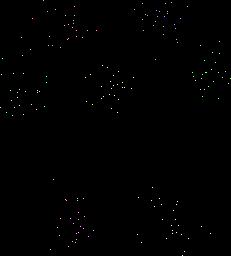Next: Clustering Analysis Up: ch9 Previous: Kernelized Bayes classifier
Both supervised classification and unsupervised clustering can be carried out in a hierarchical fashion to classify the input patterns or group them into clusters, very much like the hierarchy of biological classifications with different taxonomic ranks (domain, kingdom, phylum, class, order, family, genus, and species).
The hierarchical clustering can be obtained in either a top-down or bottom up manner.
All patterns in the data set are initially treated as a single cluster as the root of the tree, which is then subdivided (split) into a set of two or more smaller clusters, each represented as a node in the tree structure. This process is carried out recursively until eventually each cluster contains only one pattern, represented as a leaf node of the tree.
every pattern in the data set is initially treated as a cluster as a leaf node of the tree, which will then be merged to form larger clusters. Again, this process is carried out recursively until eventually all patterns are merged into a single cluster at the root of the tree.
In either the top-down or the bottom-up method, the specific method for the splitting or merging at each tree node is based on certain similarity measurement such as the distance between two clusters. The resulting tree structure obtained by either method can then be truncated at any level between the root and the leaf nodes to obtain a set of clusters, depending on the desired number and sizes of these clusters.
If labeled training data are available, both the top-down and the bottom-up clustering methods can also be used in the training stage of the supervised classification methods, with the only difference that now the splitting or merging is applied to labeled classes instead of individual patterns, and each leaf node represents one of the classes, rather than a single pattern. After the tree structure is obtained, the training is complete and any unlabeled pattern can be classified at the tree root and then subsequently the tree nodes at lower levels until it is classified into one of the leaf nodes of the tree, corresponding to a specific class.
This hierarchical classification method is especially useful when the number
of classes and the number 



In the following we consider both the bottom-up and top-down methods for hierarchical clustering/classification.
Bottom-Up method
The bottom-up hierarchical classifier is trained based on 




 pairwise Bhattacharyya distances between
every two classes
pairwise Bhattacharyya distances between
every two classes  and
and  :
:
![$\displaystyle d_B(C_i,C_j)
=\frac{1}{4}({\bf m}_i-{\bf m}_j)^T\left[\frac{{\bf\...
...vert{\bf\Sigma}_i\right\vert\;\left\vert{\bf\Sigma}_j\right\vert)^{1/2}}\right]$](img725.svg) |
(194) |
 to form
a new class
to form
a new class
 , compute its mean and covariance:
, compute its mean and covariance:
![$\displaystyle {\bf m}_k=\frac{1}{n_i+n_j}[n_i {\bf m}_i+n_j {\bf m}_j]$](img728.svg) |
(195) |
![$\displaystyle {\bf\Sigma}_k=\frac{1}{n_i+n_j}
[n_i (\Sigma_i+({\bf m}_i-{\bf m}...
...i-{\bf m}_k)^T)+
n_j (\Sigma_j+({\bf m}_j-{\bf m}_k)({\bf m}_j-{\bf m}_k)^T ) ]$](img729.svg) |
(196) |
 and
and  . Now there are
. Now there are  classes left.
classes left.
 and all
and all  remaining classes.
remaining classes.
 classes, the binary tree
structure is thus obtained.
classes, the binary tree
structure is thus obtained.
Top-Down method
Generate a binary tree by recursively partitioning all classes into two sub-groups with the maximum Bhattacharyya distance
 of the
of the
 classes, find its maximum eigenvalue
classes, find its maximum eigenvalue  and the
corresponding eigenvectors
and the
corresponding eigenvectors  ;
;
 :
:
 |
(197) |
 along this 1-D space
and partition them into two subgroups with maximum Bhattacharyya
(between-group) distance.
along this 1-D space
and partition them into two subgroups with maximum Bhattacharyya
(between-group) distance.
Once the hierarchical structure is constructed by either the bottom-up
or top-down method, we need to build a binary classifier at each node
of structure, by which any given pattern is classified into either the
left group 

 and
and
 for the
two subgroups based on the training data.
for the
two subgroups based on the training data.
 features most suitable for separating the
two groups
features most suitable for separating the
two groups  and
and  , based on any of the feature selection
methods such as those listed below:
, based on any of the feature selection
methods such as those listed below:
 features directly from the
features directly from the  original ones using
between-class distance (Bhattacharrya distance) as the criterion,
original ones using
between-class distance (Bhattacharrya distance) as the criterion,
 and use the first
and use the first  principal components for the binary classification.
principal components for the binary classification.
 can be expected to be small.
can be expected to be small.
 enters the classifier at the root of
the tree and is classified to either the left or the right sub-group
of the node according to the discriminant function
enters the classifier at the root of
the tree and is classified to either the left or the right sub-group
of the node according to the discriminant function
 |
(198) |
 reaches one of the leaf nodes corresponding
to a single class, to which the sample
reaches one of the leaf nodes corresponding
to a single class, to which the sample  is therefore classified.
is therefore classified.
Example
The hierarchical clustering method is applied to a dataset composed of
seven normally distributed clusters each containing 25 sample vectors in an 

The clustering result is shown below. Each column in the display represents the four components of a 4-D vector, color coded by a spectrum from red (low values) through green (middle) to blue (high values).

See more examples in clustering analysis applied to gene data analysis in bioinformatics.
An example of this method is available here.